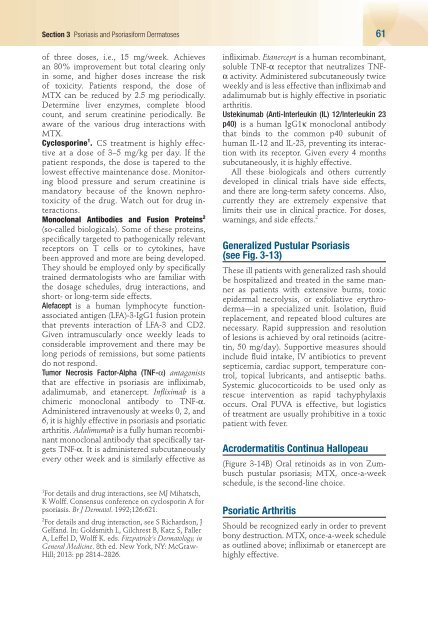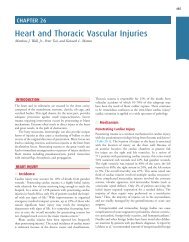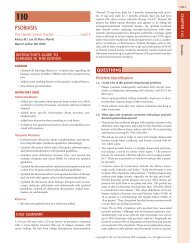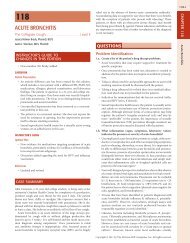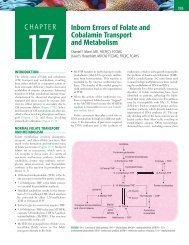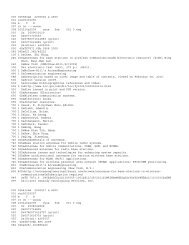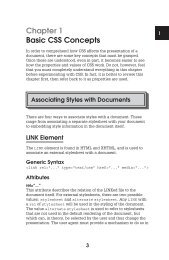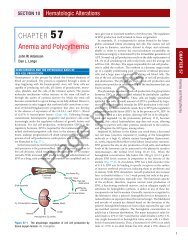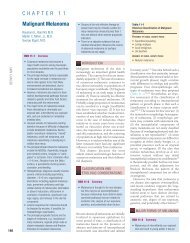TOC and Sample Chapters - McGraw-Hill Professional
TOC and Sample Chapters - McGraw-Hill Professional
TOC and Sample Chapters - McGraw-Hill Professional
Create successful ePaper yourself
Turn your PDF publications into a flip-book with our unique Google optimized e-Paper software.
Section 3 Psoriasis <strong>and</strong> Psoriasiform Dermatoses 61<br />
of three doses, i.e., 15 mg/week. Achieves<br />
an 80% improvement but total clearing only<br />
in some, <strong>and</strong> higher doses increase the risk<br />
of toxicity. Patients respond, the dose of<br />
MTX can be reduced by 2.5 mg periodically.<br />
Determine liver enzymes, complete blood<br />
count, <strong>and</strong> serum creatinine periodically. Be<br />
aware of the various drug interactions with<br />
MTX.<br />
Cyclosporine 1 . CS treatment is highly effective<br />
at a dose of 3–5 mg/kg per day. If the<br />
patient responds, the dose is tapered to the<br />
lowest effective maintenance dose. Monitoring<br />
blood pressure <strong>and</strong> serum creatinine is<br />
m<strong>and</strong>atory because of the known nephrotoxicity<br />
of the drug. Watch out for drug interactions.<br />
Monoclonal Antibodies <strong>and</strong> Fusion Proteins 2<br />
(so-called biologicals). Some of these proteins,<br />
specifically targeted to pathogenically relevant<br />
receptors on T cells or to cytokines, have<br />
been approved <strong>and</strong> more are being developed.<br />
They should be employed only by specifically<br />
trained dermatologists who are familiar with<br />
the dosage schedules, drug interactions, <strong>and</strong><br />
short- or long-term side effects.<br />
Alefacept is a human lymphocyte functionassociated<br />
antigen (LFA)-3-IgG1 fusion protein<br />
that prevents interaction of LFA-3 <strong>and</strong> CD2.<br />
Given intramuscularly once weekly leads to<br />
considerable improvement <strong>and</strong> there may be<br />
long periods of remissions, but some patients<br />
do not respond.<br />
tumor necrosis Factor-Alpha (tnF-α) antagonists<br />
that are effective in psoriasis are infliximab,<br />
adalimumab, <strong>and</strong> etanercept. Infliximab is a<br />
chimeric monoclonal antibody to TNF-α.<br />
Administered intravenously at weeks 0, 2, <strong>and</strong><br />
6, it is highly effective in psoriasis <strong>and</strong> psoriatic<br />
arthritis. Adalimumab is a fully human recombinant<br />
monoclonal antibody that specifically targets<br />
TNF-α. It is administered subcutaneously<br />
every other week <strong>and</strong> is similarly effective as<br />
1<br />
For details <strong>and</strong> drug interactions, see MJ Mihatsch,<br />
K Wolff. Consensus conference on cyclosporin A for<br />
psoriasis. Br J Dermatol. 1992;126:621.<br />
2<br />
For details <strong>and</strong> drug interaction, see S Richardson, J<br />
Gelf<strong>and</strong>. In: Goldsmith L, Gilchrest B, Katz S, Paller<br />
A, Leffel D, Wolff K. eds. Fitzpatrick’s Dermatology, in<br />
General Medicine. 8th ed. New York, NY: <strong>McGraw</strong>-<br />
<strong>Hill</strong>; 2013: pp 2814–2826.<br />
infliximab. Etanercept is a human recombinant,<br />
soluble TNF-α receptor that neutralizes TNFα<br />
activity. Administered subcutaneously twice<br />
weekly <strong>and</strong> is less effective than infliximab <strong>and</strong><br />
adalimumab but is highly effective in psoriatic<br />
arthritis.<br />
Ustekinumab (Anti-interleukin (iL) 12/interleukin 23<br />
p40) is a human IgG1κ monoclonal antibody<br />
that binds to the common p40 subunit of<br />
human IL-12 <strong>and</strong> IL-23, preventing its interaction<br />
with its receptor. Given every 4 months<br />
subcutaneously, it is highly effective.<br />
All these biologicals <strong>and</strong> others currently<br />
developed in clinical trials have side effects,<br />
<strong>and</strong> there are long-term safety concerns. Also,<br />
currently they are extremely expensive that<br />
limits their use in clinical practice. For doses,<br />
warnings, <strong>and</strong> side effects. 2<br />
Generalized Pustular Psoriasis<br />
(see Fig. 3-13)<br />
These ill patients with generalized rash should<br />
be hospitalized <strong>and</strong> treated in the same manner<br />
as patients with extensive burns, toxic<br />
epidermal necrolysis, or exfoliative erythroderma—in<br />
a specialized unit. Isolation, fluid<br />
replacement, <strong>and</strong> repeated blood cultures are<br />
necessary. Rapid suppression <strong>and</strong> resolution<br />
of lesions is achieved by oral retinoids (acitretin,<br />
50 mg/day). Supportive measures should<br />
include fluid intake, IV antibiotics to prevent<br />
septicemia, cardiac support, temperature control,<br />
topical lubricants, <strong>and</strong> antiseptic baths.<br />
Systemic glucocorticoids to be used only as<br />
rescue intervention as rapid tachyphylaxis<br />
occurs. Oral PUVA is effective, but logistics<br />
of treatment are usually prohibitive in a toxic<br />
patient with fever.<br />
Acrodermatitis Continua Hallopeau<br />
(Figure 3-14B) Oral retinoids as in von Zumbusch<br />
pustular psoriasis; MTX, once-a-week<br />
schedule, is the second-line choice.<br />
Psoriatic Arthritis<br />
Should be recognized early in order to prevent<br />
bony destruction. MTX, once-a-week schedule<br />
as outlined above; infliximab or etanercept are<br />
highly effective.


